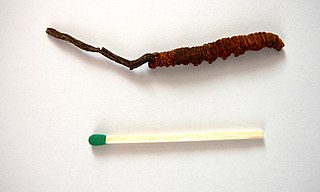
Ophiocordyceps sinensis, known colloquially as caterpillar fungus, is an entomopathogenic fungus in the family Ophiocordycipitaceae. It is mainly found in the meadows above 3,500 metres (11,500 ft) on the Tibetan Plateau in Tibet and the Himalayan regions of Bhutan, India, and Nepal. It parasitizes larvae of ghost moths and produces a fruiting body which is valued in traditional Chinese medicine as an aphrodisiac. Caterpillar fungus contains the compound cordycepin, an adenosine derivative. However, the fruiting bodies harvested in nature usually contain high amounts of arsenic and other heavy metals, so they are potentially toxic and sales have been strictly regulated by China's State Administration for Market Regulation since 2016.
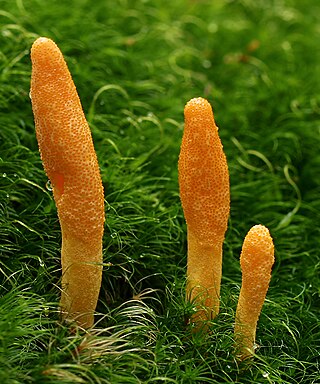
Cordyceps is a genus of ascomycete fungi that includes about 600 worldwide species. Diverse variants of cordyceps have had more than 1,500 years of use in Chinese medicine. Most Cordyceps species are endoparasitoids, parasitic mainly on insects and other arthropods ; a few are parasitic on other fungi.

An entomopathogenic fungus is a fungus that can kill or seriously disable insects.

Paecilomyces is a genus of fungi. A number of species in this genus are plant pathogens.

Pichia is a genus of yeasts in the family Pichiaceae with spherical, elliptical, or oblong acuminate cells. Pichia is a teleomorph, and forms hat-shaped, hemispherical, or round ascospores during sexual reproduction. The anamorphs of some Pichia species are Candida species. The asexual reproduction is by multilateral budding.
Hyphomycetes are a form classification of fungi, part of what has often been referred to as fungi imperfecti, Deuteromycota, or anamorphic fungi. Hyphomycetes lack closed fruit bodies, and are often referred to as moulds. Most hyphomycetes are now assigned to the Ascomycota, on the basis of genetic connections made by life-cycle studies or by phylogenetic analysis of DNA sequences; many remain unassigned phylogenetically.

Beauveria is a genus of asexually-reproducing fungi allied with the ascomycete family Cordycipitaceae. Its several species are typically insect pathogens. The sexual states (teleomorphs) of Beauveria species, where known, are species of Cordyceps.

Metarhizium is a genus of entomopathogenic fungi in the Clavicipitaceae family. With the advent of genetic profiling, placing these fungi in proper taxa has now become possible. Most turn out to be the asexual forms (anamorphs) of fungi in the phylum Ascomycota, including Metacordyceps spp.
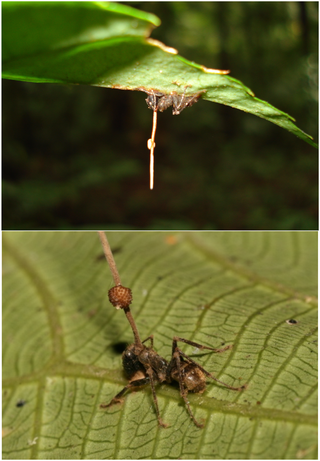
Ophiocordyceps is a genus of fungi within the family Ophiocordycipitaceae. The widespread genus, first described scientifically by British mycologist Tom Petch in 1931, contains about 140 species that grow on insects. Anamorphic genera that correspond with Ophiocordyceps species are Hirsutella, Hymenostilbe, Isaria, Paraisaria, and Syngliocladium.

Isaria sinclairii is a species of entomopathogenic fungus mostly infecting the underground nymphs of cicadas. It produces myriocin, from which the synthetic drug fingolimod, a treatment for multiple sclerosis, was developed.

Purpureocillium lilacinum is a species of filamentous fungus in the family Ophiocordycipitaceae. It has been isolated from a wide range of habitats, including cultivated and uncultivated soils, forests, grassland, deserts, estuarine sediments and sewage sludge, and insects. It has also been found in nematode eggs, and occasionally from females of root-knot and cyst nematodes. In addition, it has frequently been detected in the rhizosphere of many crops. The species can grow at a wide range of temperatures – from 8 to 38 °C for a few isolates, with optimal growth in the range 26 to 30 °C. It also has a wide pH tolerance and can grow on a variety of substrates. P. lilacinum has shown promising results for use as a biocontrol agent to control the growth of destructive root-knot nematodes.
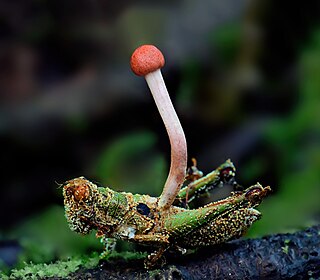
Paraisaria is a genus of fungi in the Ophiocordycipitaceae family. Members are anamorph names of Ophiocordyceps.
Syngliocladium is a genus of anamorphic fungi within the Ophiocordycipitaceae family. Members are anamorph names of Ophiocordyceps.
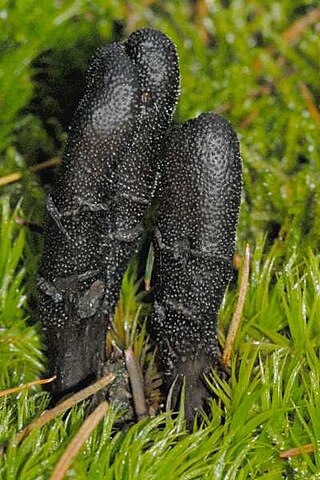
Tolypocladium ophioglossoides, also known by two of its better known synonyms Elaphocordyceps ophioglossoides and Cordyceps ophioglossoides and commonly known as the goldenthread cordyceps, is a species of fungus in the family Ophiocordycipitaceae. It is parasitic on fruit bodies of the truffle-like Elaphomyces. The specific epithet ophioglossoides, derived from Ancient Greek, means "like a snake's tongue". The species is thought to be inedible by people in the Western hemisphere, however, Traditional Chinese medicine of the Eastern Hemisphere recognizes T. ophioglossoides as a valuable medicinal fungi.

Cordyceps militaris is a species of fungus in the family Cordycipitaceae, and the type species of the genus Cordyceps. It was originally described by Carl Linnaeus in 1753 as Clavaria militaris. There are hundreds of species of cordyceps fungi. Special characteristics of Cordyceps Militaris are its use in traditional Chinese medicine, modern pharmaceuticals, and its relationship with insects and how it disperses.

The Cordycipitaceae are a family of parasitic fungi in the Ascomycota, class Sordariomycetes and order Hypocreales. The family was first published in 1969 by mycologist Hanns Kreisel, but the naming was invalid according to the code of International Code of Nomenclature for algae, fungi, and plants. It was validly published in 2007.

Isaria is a genus of fungi mostly in the order Hypocreales and family Clavicipitaceae, or by some authorities the Cordycipitaceae. It includes a large number of entomopathogenic species, some of them exploited as biopesticides : often previously assigned to the genus Paecilomyces.

Mariannaea is a genus of fungi belonging to the family Nectriaceae.

Cordyceps locustiphila is the basionym and teleomorph of the fungi Beauveria locustiphila, a species of fungus in the family Cordycipitaceae. and is a species within the genus Cordyceps. It was originally described in by Henn in 1904. C. locustiphila is an entomopathogen and obligate parasite of the grasshopper species within the genus Colpolopha or Tropidacris, and as such is endemic to South America. The scientific name is derived from its close relationship with its host, being named after locusts. The fungi was renamed to Beauveria locustiphila in 2017 following research into the family Cordycipitaceae. Following the loss of the species type specimen, new studies were conducted that now recommend that the fungi be divided into 3 species. C. locustiphila, C. diapheromeriphila, and C. acridophila.

Isaria cicadae is an ascomycete fungus that parasitizes cicada larvae. It forms white and yellow asexual fruiting structures resembling synnema. While mostly being found throughout Asia in warm, humid regions, it has been found on various other continents. It is known in Traditional Chinese Medicine as Chan Hua and commonly called “cicada flower.” Its medicinal uses date back to the fifth century AD in China. It can also be used in various foods and tonics.















